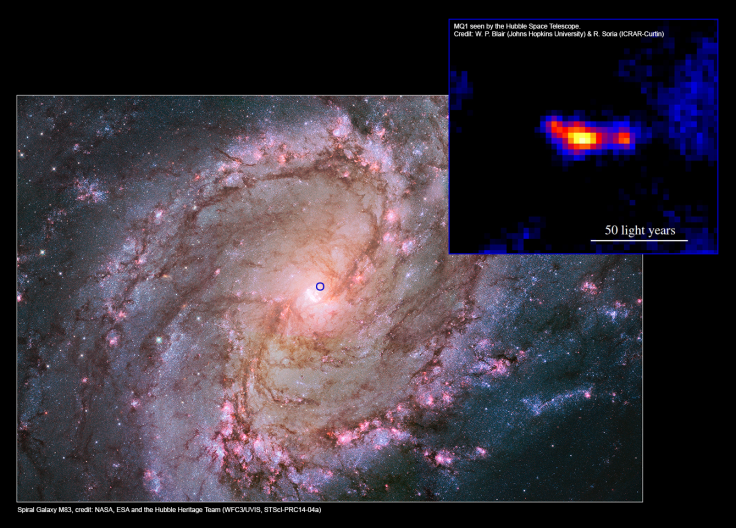Superpowered Small Black Hole MQ1 Is Just 62 Miles Wide But Packs A Punch With Two Huge Jets
Astronomers have discovered a small but incredibly powerful black hole. MQ1, located in the M83 galaxy, is just 62 miles wide, but is powered by two huge jets that shoot out 20 light years from either side of the black hole.

Lead researcher Roberto Soria, a senior research fellow at Curtin University, said the team of Australian and American astronomers used the Hubble space telescope, the Magellan telescope, the Chandra X-ray observatory, the Australia telescope compact and the Very Large Array to observe MQ1 in visible light, track X-ray emissions and radiation. It was previously believed MQ1 was a larger black hole but the new research has shown it is a small black hole.
The M83 galaxy is located 15 million light-years from Earth in the constellation Hydra. Much like our Milky Way galaxy, M83 is a barred spiral galaxy. It is believed MQ1 is a stellar mass black hole, formed by the collapse of a star. A stellar mass black hole is incredibly dense, with a mass five to 10 times that of the sun, notes NASA.
According to Soria, the black hole is classified as a microquasar, a black hole accreting matter from a companion star. As the black hole gathers more material it forms an accretion disk. At the very fringe of this disk, just before the point of no return, the material can get hot and speed up, forming jets at either side of the spin axis of the black hole, reports NASA.
While the black hole itself is small, it contains two jets that are shaping its surrounding environment and are an important factor in the evolution of a galaxy. Soria said in a statement, “The significance of the huge jet power measured for MQ1 goes beyond this particular galaxy: it helps astronomers understand and quantify the strong effect that black hole jets have on the surrounding gas, which gets heated and swept away.”
Soria and his team measured the strength of the jets by observing the size and brightness of the "bubble" of heated gas that envelops the jet as it collides with its surroundings. Discussing the study in the Conversation, Soria said, "We inferred a huge jet power, a few million times higher than the total power of the sun," althoug that type of power is not too uncommon in the universe.
MQ1 and other powerful black holes were more common in the early universe and these powerful jets could reduce star formation in galaxies as the streams push gas outward, thus affecting galaxy evolution. The study was published in the journal Science.
© Copyright IBTimes 2024. All rights reserved.






















